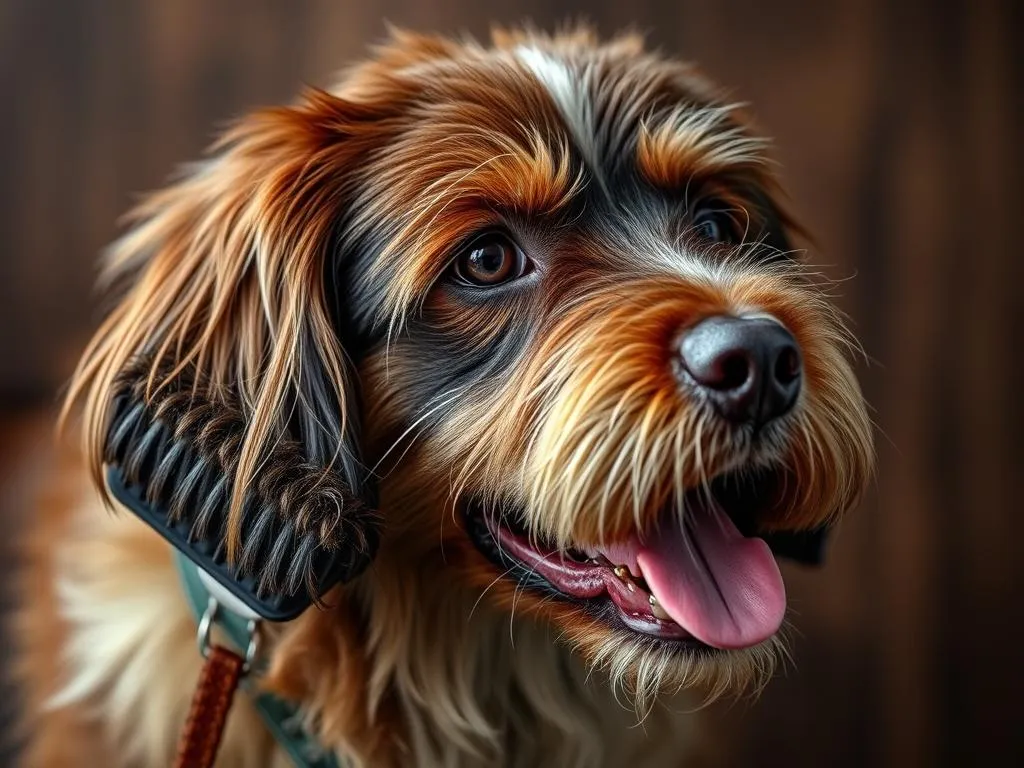
Introduction
Maintaining a dog’s health is crucial for their overall well-being and happiness. Just like humans, dogs require regular care and attention to thrive. While many pet owners focus on aspects like diet and exercise, grooming is an equally important component of dog health care. Grooming not only contributes to a dog’s physical appearance but also plays a vital role in their health by promoting a clean coat and skin.
One of the most common challenges dog owners face is shedding. Dogs shed for various reasons, and understanding this natural process is essential for effective grooming. This article will delve into the reasons behind dog shedding and introduce you to the best dog brushes for shedding, ensuring that you are well-equipped to manage your furry friend’s coat.
Understanding Dog Shedding
What is Dog Shedding?
Shedding is a natural process where dogs lose old or damaged fur to make way for new growth. This cycle is essential for their health, allowing them to maintain a clean and healthy coat. Different breeds shed at varying rates, and the frequency of shedding can also be influenced by factors such as season and overall health.
Reasons Why Dogs Shed
There are several reasons why dogs shed:
-
Seasonal Shedding: Many dogs experience increased shedding during seasonal transitions, particularly in the spring and fall. This is a natural response to changes in temperature and daylight.
-
Breed-Specific Shedding Patterns: Certain breeds are more prone to shedding than others. For instance, double-coated breeds like Huskies and Golden Retrievers typically shed more than single-coated breeds.
-
Health-Related Causes: Excessive shedding can indicate underlying health issues, such as allergies, skin conditions, or hormonal imbalances. If you notice your dog shedding more than usual, it may be time for a vet visit.
Identifying Shedding Patterns
Understanding your dog’s shedding patterns can help determine whether their shedding is normal or excessive. Here are some signs to watch for:
-
Normal Shedding: If your dog sheds a moderate amount of hair regularly, particularly during seasonal changes, this is typically normal.
-
Excessive Shedding: If your dog is losing large clumps of hair, or if you notice bald patches or skin irritation, it may indicate a health issue that requires veterinary attention.
Importance of Grooming for Dog Health
Benefits of Regular Grooming
Regular grooming offers numerous benefits beyond just keeping your dog looking good:
-
Reducing Shedding: Consistent grooming helps remove loose fur, minimizing the amount of hair that ends up around your home.
-
Promoting Healthy Skin and Coat: Grooming stimulates circulation and distributes natural oils throughout the coat, promoting a shiny and healthy appearance.
-
Improving Bond Between Dog and Owner: Grooming is an excellent opportunity for bonding with your pet, enhancing your relationship through positive interactions.
Grooming Tools Overview
To achieve effective grooming, it’s essential to have the right tools. Using appropriate grooming tools tailored to your dog’s coat type can make a significant difference. Here are some of the essential tools every dog owner should consider:
-
Brushes: Various types of brushes are available, each designed for different coat types and shedding levels.
-
Combs: Combs can help detangle fur and remove loose hair, especially for long-haired breeds.
-
Deshedding Tools: These specialized tools are designed to remove undercoat fur and reduce shedding significantly.
Best Dog Brushes for Shedding
Types of Dog Brushes
Choosing the right brush is crucial in managing shedding. Here’s an overview of some popular brush types:
-
Slicker Brushes: These brushes have fine, short wires close together, making them effective for removing mats and tangles, especially in long-haired breeds.
-
Undercoat Rakes: Specifically designed for dogs with a thick undercoat, these rakes help remove loose fur without damaging the top coat.
-
Bristle Brushes: Ideal for short-haired breeds, these brushes help distribute oils and remove surface dirt.
-
Deshedding Tools: These tools are excellent for heavy shedders, effectively removing loose fur from the undercoat.
Top Recommendations for Brushes
Slicker Brushes
Slicker brushes are a favorite among many dog owners for their efficiency in tackling tangles and mats.
- Recommended Brands:
- Hertzko Self Cleaning Slicker Brush
- Pet Neat Pet Grooming Brush
Undercoat Rakes
Undercoat rakes are perfect for breeds with thick undercoats, effectively reducing shedding.
- Recommended Brands:
- Furminator Undercoat Rake
- Hertzko Undercoat Rake
Bristle Brushes
For dogs with short, smooth coats, bristle brushes are ideal for maintaining a clean and healthy coat.
- Recommended Brands:
- Pet Ag Dog Brush
- Hartz Groomer’s Best Combo Brush
Deshedding Tools
Deshedding tools are specifically designed to reduce shedding significantly, making them a must-have for owners of heavy shedders.
- Recommended Brands:
- Furminator deShedding Tool
- Hertzko Self Cleaning Deshedding Tool
How to Choose the Right Brush for Your Dog
Selecting the right brush depends on several factors:
-
Breed: Different breeds have unique coat types, which require specific grooming tools.
-
Coat Type: Consider whether your dog has a short, medium, or long coat.
-
Shedding Level: If your dog is a heavy shedder, opt for tools designed specifically for deshedding.
When purchasing brushes, consider testing them on your dog’s coat to see how effective they are at removing loose hair.
Grooming Techniques for Reducing Shedding
Brushing Frequency
The frequency of brushing should be tailored to your dog’s breed and coat type:
-
Short-Haired Breeds: Typically require brushing once a week.
-
Medium-Haired Breeds: Should be brushed two to three times a week.
-
Long-Haired Breeds: Require daily brushing to prevent tangles and mats.
Watch for changes in your dog’s shedding patterns to determine if more frequent brushing is needed.
Proper Brushing Techniques
To effectively brush your dog, follow these steps:
-
Choose the Right Brush: Use the appropriate brush for your dog’s coat type.
-
Start Slowly: Introduce the brush gradually, allowing your dog to become comfortable with it.
-
Brush in the Direction of Hair Growth: This technique helps prevent discomfort and ensures effective removal of loose hair.
-
Pay Attention to Problem Areas: Focus on areas that may be prone to mats or tangles.
-
Reward Your Dog: Use treats and praise to create a positive association with grooming.
Additional Grooming Practices
In addition to brushing, consider these practices:
-
Bathing: Regular baths can help manage shedding by loosening dead hair. Use a quality dog shampoo that promotes skin health.
-
Nail Trimming: Regular nail trimming is essential for your dog’s comfort and mobility.
-
Ear Cleaning: Routine ear cleaning helps prevent infections and contributes to overall health.
Maintaining Overall Dog Health
Nutrition and Diet
A well-balanced diet is fundamental for a healthy coat. Ensure your dog receives:
-
High-Quality Protein: Essential for hair growth and maintenance.
-
Healthy Fats: Omega-3 and Omega-6 fatty acids can improve coat condition.
Consider adding supplements specifically designed for skin and coat health if recommended by your veterinarian.
Regular Vet Check-ups
Routine veterinary check-ups are vital for monitoring your dog’s health. They can help identify:
-
Allergies: Common culprits that can lead to excessive shedding.
-
Skin Conditions: Conditions like dermatitis can affect coat health.
Exercise and Mental Stimulation
Physical activity and mental stimulation are crucial for your dog’s overall well-being. Regular exercise can help reduce stress, which may, in turn, help minimize stress-related shedding. Activities such as:
-
Daily Walks: Essential for physical health.
-
Interactive Play: Engaging in games like fetch can provide both mental and physical stimulation.
Conclusion
In conclusion, addressing shedding is a vital aspect of dog health care. Regular grooming not only helps manage shedding but also promotes a healthy coat and strengthens the bond between you and your furry friend. By understanding the causes of shedding and using the best dog brushes for shedding, you can significantly improve your dog’s grooming routine and overall health.
Incorporate regular grooming practices, maintain a balanced diet, and ensure routine vet visits to keep your dog happy and healthy. Taking proactive steps today will lead to a lifetime of well-being for your beloved companion.









